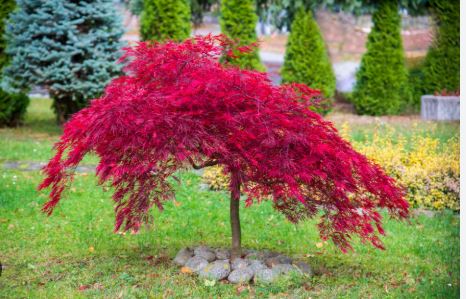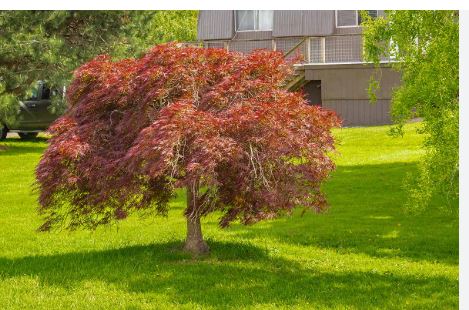
Weeping Japanese maples are primarily cultivars of Acer palmatum var. dissectum, a variety within the Sapindaceae family, which encompasses maples, horse chestnuts, and lychees. The genus Acer includes around 150 species, with Acer palmatum serving as the primary source for these cascading forms, though some weeping traits appear in Acer japonicum.
The term dissectum refers to their finely cut, lace-like leaves, and weeping cultivars, such as ‘Crimson Queen’ or ‘Tamukeyama,’ are horticultural selections bred for their drooping habit. Their classification as cultivars reflects centuries of Japanese horticulture, tailoring these maples for ornamental elegance in gardens and bonsai.
Weeping Japanese maples are compact, deciduous shrubs or small trees, typically growing 4–10 feet (1.2–3 meters) tall and 6–12 feet (1.8–3.6 meters) wide, with a distinctive cascading, mounded form. Their lace-like leaves, 2–5 inches (5–13 cm) long, are deeply lobed with 7–11 finely serrated segments, displaying colors from green and red to purple, turning vibrant scarlet, orange, or gold in fall.
The arching branches, often touching the ground, create a waterfall effect, with some cultivars showing colorful bark in winter. Small, red-purple flowers bloom in spring, followed by winged samaras, 0.5–1 inch (1.3–2.5 cm) long. Their slow growth (6–12 inches/15–30 cm per year) and delicate structure make them ideal for intimate spaces.
The parent species, Acer palmatum, is native to Japan, South Korea, eastern China, and parts of Russia and Mongolia, where it thrives in cool, temperate forests, often as an understory plant on wooded slopes or streambanks. Weeping cultivars, specifically Acer palmatum var. dissectum, do not occur in the wild, having been developed through Japanese horticultural practices dating back centuries. These cultivars are now cultivated globally, particularly in North America, Europe, Australia, and New Zealand, adorning gardens, parks, and urban landscapes. Their distribution is entirely ornamental, propagated by nurseries for aesthetic use rather than naturalized populations.
Weeping Japanese maples are hardy in USDA zones 5a–9b, tolerating winter lows down to -20°F (-29°C), though young plants may need protection below -10°F (-23°C) to prevent branch dieback. They thrive in temperate climates with mild summers, ideally 50°F to 80°F (10°C–27°C), suited to coastal, inland, and mild southern regions. In zones 8–9, they require afternoon shade to avoid leaf scorch in intense heat. Below zone 5a, they can be grown in containers and sheltered during harsh winters, needing well-drained, slightly acidic soil (pH 5.5–6.5) to flourish in diverse climates.
Weeping Japanese maples are prized in landscaping for their graceful, cascading forms and vibrant foliage, making them ideal focal points in small gardens, courtyards, or Zen-inspired designs. Their drooping branches excel near water features, over low walls, or in rock gardens, where they create a serene, waterfall-like effect.
Planted as specimens, they add elegance to patios or entryways; in containers, they enhance balconies or terraces, especially in urban settings. They pair well with shade-tolerant perennials or ferns in woodland gardens, attracting minimal wildlife but offering seasonal drama. Their slow growth and compact size suit bonsai or mixed borders, though they require protection from strong winds and harsh sun to maintain leaf health, ensuring a stunning display year-round.

Weeping Japanese Maples: How to Grow and Care
Light Requirements
Provide partial shade to dappled sunlight, with 4–6 hours of morning sun ideal to enhance leaf color without scorching. Afternoon shade is critical in hot climates to protect delicate foliage. In cooler zones, they tolerate more sun, but indoors, place near an east-facing window or under grow lights to mimic filtered light.
Soil Preferences
Plant in well-draining, slightly acidic soil (pH 5.5–6.5), such as loamy or sandy soil enriched with organic matter like compost or peat moss. Avoid heavy clay or alkaline soils, which stress roots; amend with perlite for drainage. In containers, use a high-quality, acid-loving plant mix to support healthy growth.
Watering Needs
Keep soil consistently moist but not waterlogged, watering 1–2 inches (2.5–5 cm) weekly during the growing season (spring–summer). Reduce to every 2–3 weeks in fall–winter, ensuring soil dries slightly between waterings. Overwatering causes root rot, while underwatering leads to leaf drop, so check soil moisture regularly.
Temperature Range
Grow in USDA zones 5a–9b, tolerating lows of -20°F (-29°C), though young plants need protection below -10°F (-23°C). They thrive at 50°F to 80°F (10°C–27°C). In zones 8–9, provide shade to prevent heat stress. In colder zones, cultivate in pots and move indoors or to a sheltered area in winter, maintaining above 40°F (4°C).
Humidity Levels
Prefer moderate humidity (40–60%), typical of temperate regions. Low humidity in arid climates may cause leaf tips to brown; mist occasionally or use a pebble tray for potted plants. Ensure good air circulation to prevent fungal issues, avoiding overly humid, stagnant conditions indoors or out.
Container Selection
Choose wide, shallow pots with drainage holes, 18–24 inches (45–60 cm) in diameter, to accommodate spreading roots and cascading branches. Terracotta or glazed ceramic pots add stability and aesthetics. Repot every 2–3 years to refresh soil, ensuring the container supports the tree’s weeping form without tipping.
Fertilization
Apply a balanced, slow-release fertilizer for acid-loving plants (e.g., 10-10-10 or 4-8-8 NPK) in early spring, followed by a light application in early summer. Alternatively, use diluted liquid fertilizer monthly during spring–summer. Avoid over-fertilizing, as excess nitrogen causes weak growth and dulls fall colors.
Pruning
Prune minimally in late winter or early spring to shape the canopy, remove dead or crossing branches, or thin dense areas for airflow. Use clean, sharp shears, cutting just above a bud. Avoid heavy pruning, as it disrupts the natural weeping form; focus on maintaining balance and removing suckers from grafted trees.
Propagation
Propagate via softwood cuttings or grafting, as seeds rarely breed true. Take 4–6-inch (10–15 cm) cuttings in early summer, dip in rooting hormone, and plant in a moist, well-draining mix; roots form in 6–8 weeks. Grafting, typically onto Acer palmatum rootstock, is common for cultivars and best left to professionals.
Pest Control
Monitor for pests like aphids, scale, or spider mites, which target tender leaves. Inspect foliage regularly, treating infestations with insecticidal soap or neem oil in early morning. Maintain consistent watering and avoid stress from drought or poor soil, as healthy trees resist pests better.
Repotting
Repot container-grown maples every 2–3 years in early spring, before new growth begins. Gently remove, trim circling roots, and replant in fresh, acidic mix at the same depth. Water lightly after repotting and keep in shade for a week to reduce shock, ensuring the pot has ample drainage.
Winter Care
In zones 5a–7a, mulch the base with 2–3 inches (5–7.5 cm) of bark or compost to insulate roots against freezes. Wrap young trees in burlap if harsh winds or heavy snow are expected. Potted maples indoors need bright, cool conditions (40–50°F/4–10°C) and minimal water to mimic dormancy.
Common Issues
Address leaf scorch (brown, crispy edges) by increasing shade or watering during heat. Overwatering (yellow leaves, root rot) requires better drainage and less frequent watering. Poor fall color may indicate too much nitrogen or shade; adjust fertilizer or light exposure. Verticillium wilt, a soil-borne fungus, is rare but serious—remove affected branches and avoid overwatering.